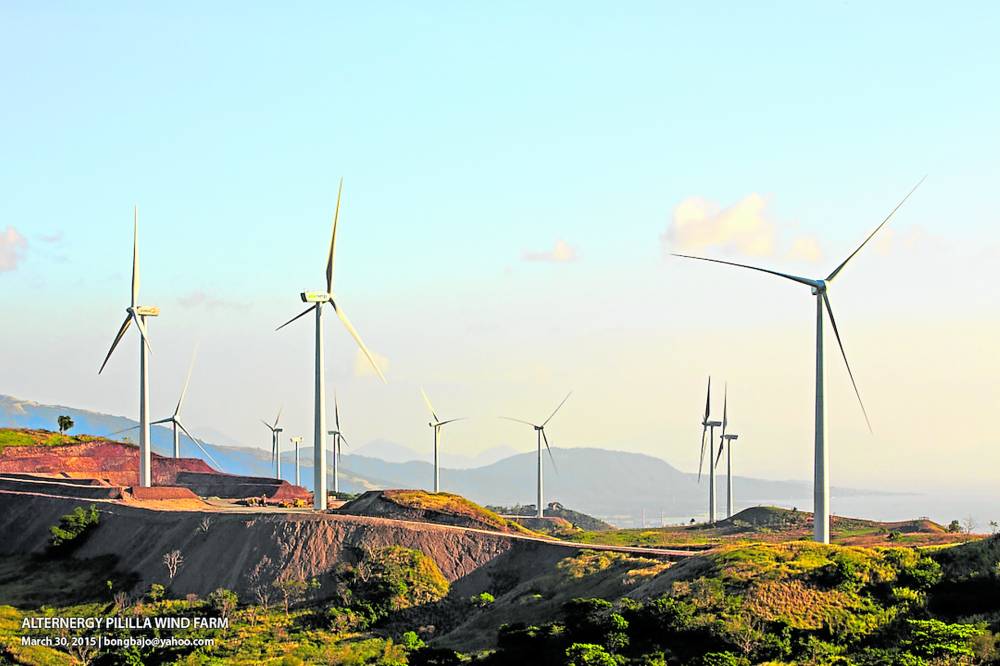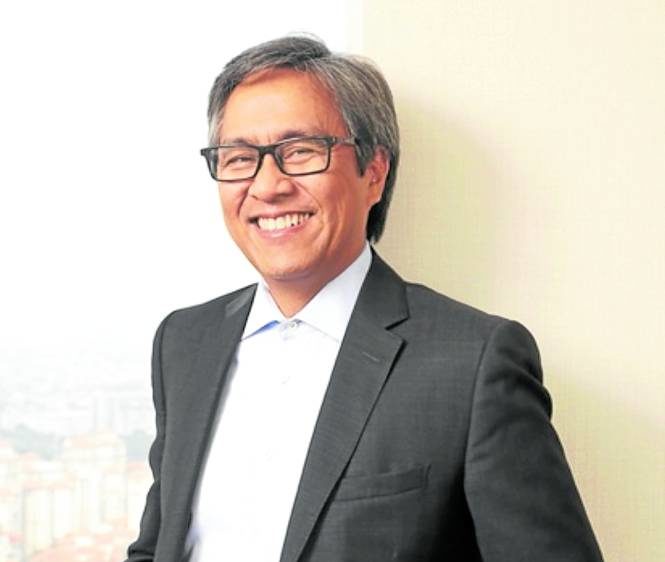Vince Perez’s triple RE strategy

LANDMARK The windmills of Pililla have become a tourist attraction —Contributed photos
Some people aspire to leave their mark on the urban skyline by building a skyscraper with their name or business logo on it.
But not Vicente “Vince” Perez Jr., renewable energy (RE) pioneer, sustainability advocate, former energy secretary, banker, private equity investor and, at age 64, a new dad.
“I’d rather leave behind something that my daughter could see when she grows up. She could point to the wind turbines and say, my dad built that wind farm,” the cofounder and chair of RE developer and operator Alternergy Holdings Corp. says in an interview with the Inquirer.
Perez must be a big fan of the number three, which is lucky in Chinese numerology as it indicates “stability.” He has no Chinese blood although he did go to Xavier School as his forward-looking father, a navy man, wanted him to learn Chinese. Thus, he has known some of today’s tycoons since they were in little-boy shorts.
Alternergy, which recently received the green light from the Philippine Stock Exchange to launch its P1.87-billion initial public offering, is not the first to bring an RE play to the market, even if his group is the most experienced in this space and even blazed the trail in the whole of Southeast Asia, long before the enabling RE law was passed in this country.
Maybe there’s a bit of regret that he had not done it sooner. But there’s a time and place for everything, and what Alternergy now brings to the table is the so-called triple RE play.
“We felt if you’re just in wind—wind blows from amihan in October to March, then after that it dies—[so if] it’s wet and rainy, you’re underproducing the capacity,” he says.
Adding run-of-the-river hydro capacity, as well as solar energy that is pretty much steady all year round, but with extra upside during the summer months, is seen as the best strategy to harness what nature has to offer in this part of the world.
“If you combine those three [technologies] with those seasonality, then you could provide a steady cash flow, which is our first bottom line metric, enough to pay the debt and pay the shareholders,” Perez says.
“That’s how we differentiate ourselves from the solar guys who have done this [listing ahead of us],” he adds.
Alternergy so far has 10 operating assets with a combined capacity of 70.6 megawatts (MW). Five more are under construction that will give another 72 MW while seven are in the predevelopment pipeline with a total capacity of 1.2 gigawatts. These are on top of battery storage power projects, including one in Palau.
One of Alternergy’s best-known operating assets is the 54-MW Pililla, Rizal, wind farm, which was switched on in June 2015.
Like the pioneering Bangui Bay wind farm in Ilocos Norte, which Perez was also part of, the Pililla project has become some sort of a tourist attraction.

Vicente Perez Jr.
From investor to regulator
Perez majored in economics at the University of the Philippines, where he first met and became a student of Gloria Macapagal-Arroyo. She also became his adviser and wrote the letter of recommendation for his Master of Business Administration (MBA) school application.
After obtaining his MBA from Wharton, he joined Mellon Bank, originally set to work at the Manila office in 1983. But as Ninoy Aquino was assassinated that year, Mellon backpedaled and assigned him instead to Latin America.
He joined Lazard in 1987, trading emerging market bonds in London and then New York.
One day, he started questioning his purpose: “Have I done anything good for the country? Have I done anything good for Peru when I bought [its bonds] at 20 and sold at 21 [cents]? Have I done anything good for Nigeria when I bought it at 35 and sold it for 38 [cents]?”
That’s when he started investing in the real economy on his private time, picking an export-oriented, labor-intensive, female-driven blue crab business in Negros that employed hundreds of women. He ran the business remotely but eventually sold out.
He eventually returned to Asia to set up Lazard’s operations, becoming the Wall Street firm’s first Asian and first Filipino partner at age 35.
In 1997, after 10 years at Lazard, he quit to form his own private equity fund called the Philippine Discovery Fund, whose notable investees were Smart Communications, then just a wireless startup, semiconductor firm Fastech and Macondray, which became Del Monte Pacific. He made money upon exiting these firms.
Meanwhile, he also got involved with El Nido resorts, originally owned by a Japanese group. He once invited his friends from World Wildlife Fund to hold their board meeting at Miniloc, which these green advocates loved.
“One guy said, ‘why don’t we buy this place? Maybe you can run it and make sure it’s run sustainably. We don’t have to make money—just protect the environment, protect the coral reefs,’” he recalls.
But as soon as the takeover was sealed, Perez had to “abandon” his partners as his former professor, Macapagal-Arroyo, who had been catapulted into presidency after People Power II, asked him to head the Board of Investments. And after only three months, he was appointed energy secretary, with the immediate task of renegotiating numerous power contracts that had been hastily signed during the Ramos administration to address a power crisis. These renegotiations saved the country billions of dollars in stranded costs over time while exposing Perez to major global energy players.
His most difficult challenge as energy czar was to implement the newly minted Electric Power Industry Reform Act. He had to set up the National Transmission Corp., Power Sector Assets and Liabilities Management Corp. and the Energy Regulatory Commission itself. In hindsight, he realizes now that he had literally so much power in his hands. In 2005 or a year after Macapagal-Arroyo began a new term as president, he retired from government service.
The entrepreneur
He describes his debut into RE as an “accident.” After stepping down as energy chief in 2005, the builders of Northwind asked for his help to raise P60 million in equity to build a transmission line. He got several investors interested but, as it was taking too long to close the deal amid the usual bureaucratic processes, he decided to put up the money himself.
By 2008, half of the Northwind partners, including Perez, wanted to take on more RE projects elsewhere in the country but the other half didn’t want to. Thus, Perez, Knud Hedeager and Gerry Magbanua decided to form Alternergy, while still owning 50 percent of Northwind.
“It was really awkward. So we said you know what? Maybe it’s time to divest,” he says. They sold their stake to Ayala Corp.
After his stint in government, he also returned to his El Nido project. They grew the business to three island-resorts and built an airstrip. In 2013, they also sold the El Nido business to the Ayalas.
Perez’s philosophy in life is based on his theory of three buckets of water.
“To be more effective in life, you have to come up with your own priorities in life, because how you spend your life is how you define yourself,” he explains.
His three buckets are family and friends, energy, and environment. Alternergy perfectly fits into all three.
Read Next
Subscribe to INQUIRER PLUS to get access to The Philippine Daily Inquirer & other 70+ titles, share up to 5 gadgets, listen to the news, download as early as 4am & share articles on social media. Call 896 6000.
For all the latest Business News Click Here
For the latest news and updates, follow us on Google News.



